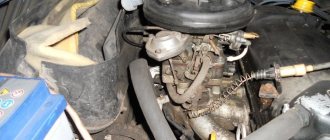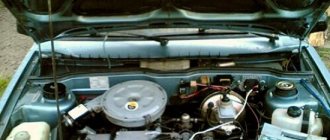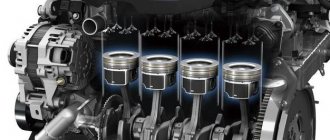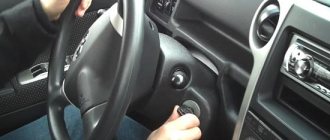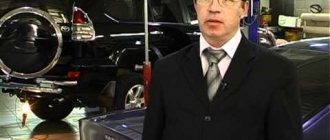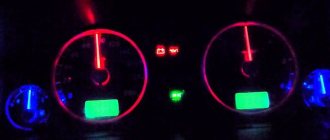Signs of tripling
A motor is a complex technical device that requires constant monitoring by the driver. Without maintenance for a long time, or if the car is operated around the clock, but maintenance is rarely carried out, changes occur in the operation of the engine, which include: noises, knocks, squeaks; power reduction; increased fuel consumption; increased asynchronous vibration; and engine tripping. There are several signs that cause the engine to start to stall:
- Rough engine operation (asynchronous vibration). That is, the motor vibrates randomly, sometimes frequent, sometimes infrequent twitching. This happens when the combustible mixture in one of the cylinders does not ignite.
- One spark plug is not working. This happens when carbon deposits or soot appear on the candle, if the candles are flooded. The problem can be solved by stripping the spark plug, heating it over a fire, burning off the carbon deposits, and checking the gap.
- The car “shoots”, that is, popping sounds are heard from the muffler. This means that there are gaps in the combustion of the combustible mixture in the working chamber of the cylinder, then the ignition is triggered and a bang occurs. This happens with carburetor engines when it was running on choke, which is why overshoot occurred.
- The car accelerates slowly or even stalls if you give the gas sharply. Signs of slow acceleration may also indicate the presence of another problem in the engine.
- Excessive fuel consumption. If one cylinder does not work or fires rarely, then the fuel supplied there simply comes out unburned from the muffler.
- The needle on the tachometer is jumping. On modern cars, a certain corresponding icon may light up on the instrument panel.
- The car jerks while driving.
Consequences
Some motorists do not attach much importance to this malfunction. And this is very wrong, because the consequences can be completely unpredictable. The first thing to note is the increased fuel consumption. If the engine stalls when cold, its consumption will definitely increase. Due to improper combustion, the fuel simply flies out into the pipe, without giving the piston the necessary mechanical push. Thus, when the engine is tripled, fuel consumption can increase by 50, 60, or even 100 percent. In this case, the mixture that is not burned in the cylinder pollutes the atmosphere, destroys the catalyst (it also oxidizes the lambda probe sensor, forming carbon deposits on it) or enters the crankcase, where it is subsequently mixed with oil. Large loads are placed on the crankshaft, engine block and the entire cylinder-piston group. And this significantly affects their resource. If the problem is not corrected in time, engine repairs can be a serious expense for you. Therefore, do not hesitate to remove this malfunction.
Causes of engine tripping
When the engine starts to rev, you can immediately hear changes in its operation. Out-of-sync motor twitching, staggering in discord. This happens that the frequency, the cycle of work is disrupted.
Here are the reasons there may be if the engine starts to stall:
- The ignition timing is incorrectly set.
- There is an air leak in the vacuum brake booster system.
- The spark plug has failed. This is the most common reason, since spark plugs are usually changed until the old ones stop working. Although it is recommended to change it every 20 thousand kilometers of passage.
- The high-voltage wire is broken. These are the wires that go onto the spark plugs.
- The capacitor has failed.
- The tightness of the intake manifold system is broken.
- A valve or piston has burned out, so compression is not created.
- The piston ring is burnt out. Due to this reason, a lot of smoke comes out of the muffler.
- The valves in the gas distribution system are not configured correctly.
- The rockers, that is, the camshaft journals, are worn out.
- The cylinder head gasket is broken.
- The valve stem seals are worn out, that is, they have hardened, pierced, or crumbled.
- If the engine is carburetor, then it often happens that the carburetor is not configured correctly, which causes the supply of fuel and air to be disrupted.
- Worn distributor shaft or turntable shaft bearing.
- The air filter is clogged and does not allow the required amount of air to pass through.
- The diaphragm of the vacuum ignition timing regulator has broken.
- Fresh sparks are not suitable for this engine.
Some of the above reasons are typical only for carburetor engines, for example, cars of the VAZ family.
One of the important rules for keeping the engine in working condition is timely periodic checking of the oil level. Check the oil level with a dipstick with two or three marks marked on it.
Safety precautions when disconnecting wires
Don't forget about safety precautions. After all, these are high-voltage wires, and not small 12-volt “laces”. First of all, you need to place a dielectric under your feet, that is, a material that does not conduct electric current through itself. This can be a rubber mat or a wooden board. Also follow the technology for disconnecting wires. Remember that you need to hold your fingers not on the cap, but on the wire itself. And, of course, it is not recommended to lean against the body with your free bare hand at this time. Remember that if you do not follow these rules, you risk receiving a high voltage electric shock.
Cold diesel troits
The reasons for diesel engine tripping differ from gasoline engines. Such an engine fails either because the required compression of the fuel mixture is not created, or because the correct fuel supply or its quality is impaired.
Reasons for diesel tripping:
- Airing.
- The glow plugs are faulty.
- The injector is jammed.
- Incorrect valve clearances.
- The timing belt (gas distribution mechanism) and fuel injection pump are not aligned correctly.
Read more about why diesel troits.
Breakdown in high-voltage wires
Less frequently, the engine stalls at idle due to a breakdown in high-voltage wires. But this problem is also completely solvable. It is best to check the serviceability of high-voltage wires in the dark - this way you will see sparks that will pass out. In this case, the engine must be running. But this method does not always help. It happens that the breakdown occurs not in the winding, but inside it, that is, the wires themselves are damaged. In this case, take a multimeter and measure the nominal resistance. Ideally, it should be no more than 20 kOhm. If you notice sparks or changes in resistance levels, replace the high-voltage wires with new ones. But remember that their lengths are different. Therefore, before purchasing, remember their length so as not to buy very short or long ones.
Why does the engine injector troit?
The reasons listed above are also typical for injection engines, except for points: 13 and 14. To the reasons for the injector, you can also add the failure of the ignition module or the injector itself is faulty, the injectors are clogged, the injector wires are broken. An experienced motor mechanic is needed to diagnose and repair the injector and injectors.
Before contacting a car service, you should try to fix it yourself. This is possible in many cases, because there are many small reasons that are easy to eliminate on your own. You should start by checking the spark plugs and high-voltage wires. It is not difficult to check the functionality of the spark plugs; you need to start the engine, put on rubber gloves (if the wire is broken, to avoid electric shock), and one by one disconnect the wire from the spark plug. If the cylinder is working as expected, then when the wire is disconnected, the sound of the motor will change and the engine will begin to shake (change vibration). If the cylinder is not working, then disconnecting the wire will not make any changes in the operation of the motor. Therefore, it is necessary to change or clean the spark plug.
Soot on candles
In a working engine, the central and side electrodes of the spark plugs should be dry and have a light brown color; a slight black coating is allowed. Black dry electrodes indicate that there is more fuel in the fuel mixture than necessary. This is an indication that there is a malfunction in the power system. In this case, it is necessary to clean the throttle valve and idle air control.
White color means the mixture is lean (not enough fuel). Reasons for this:
- low octane number;
- disruption in the mixture formation cycle;
- early ignition or air leaks.
It is necessary to clean the injector and change the gas station. To search for air leaks, it is necessary to inspect the throttle assembly, the intake manifold (body and attachment point to the cylinder head) and its pipes. The most accurate way to detect leaks is to use a smoke generator. If a defect is found at the connection, the seal must be replaced. If cracks are found on a part, it must be replaced.
A candle with oily carbon deposits indicates that oil has entered the combustion chamber (wear of the piston rings or valve stem seals). You need to check the compression using a compression gauge. The test is carried out through spark plug wells using a special adapter.
Measurements must be performed 2 times. The first is without adding oil, and the second is with adding. This will allow you to determine what exactly is worn out: oil scraper rings or valve seals. If the pressure readings are different, it means the rings are worn; if they are the same, it means the seals. To eliminate the malfunction, engine repair is necessary.
Red electrodes and insulator are the result of using low-quality fuel with a high content of additives. It is better to change the gas station so that the situation does not repeat itself. These spark plugs need to be replaced.
The presence of traces of gasoline is a sign that the spark plug is faulty and needs to be replaced.
After analyzing the carbon deposits of the spark plugs, it is necessary to check and adjust the gap between the electrodes. The size of the gap depends on the vehicle's power system and varies from 0.5 to 1.3 mm.
In most cases, cleaning off the carbon deposits and adjusting the gap will temporarily resolve the problem. If the problem persists, you need to contact specialists for a more in-depth diagnosis. The reasons may be: malfunction of sensors, engine power supply system, air leaks, etc. It will not be possible to determine them without experience and special equipment.
Why does a carburetor engine troit?
Dealing with the tripping of a carburetor engine is much easier. In general, such engines are simple due to the lack of computerized systems.
All of the above reasons in the paragraph “reasons for engine tripping” are typical for engines with a carburetor.
Here, accordingly, there can be no problems with the injector or ignition module. The most common reason for cars with such engines is that the spark plug does not work, then the wire from the distributor to the spark plug is broken, then the carburetor is incorrectly configured, then the valve burns out, then the piston burns out or the piston rings fail.
0
Author of the publication
offline 1 month
Clear smoke from the exhaust pipe
The steam coming out of the engine can be mistaken for white smoke. Steam is formed during the evaporation of accumulated liquid in cooled engine systems. Most often, the accumulation of liquid at the end of the exhaust pipe and the release of steam are observed in the cold season after starting the engine.
The engine and exhaust system components heat up and water evaporates rapidly. After the engine and exhaust system have completely warmed up, the amount of steam is reduced to a minimum or disappears completely.
The amount of steam released depends on the humidity levels in the environment; the higher they are, the longer its traces will be visible. The release of steam is not a sign of breakdown of engine parts and components; if this effect occurs, repairs are not required.
